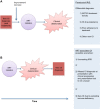Immune reconstitution inflammatory syndrome in HIV-infected patients
- PMID: 25709503
- PMCID: PMC4334287
- DOI: 10.2147/HIV.S42328
Immune reconstitution inflammatory syndrome in HIV-infected patients
Abstract
Access to antiretroviral therapy (ART) is improving worldwide. Immune reconstitution inflammatory syndrome (IRIS) is a common complication of ART initiation. In this review, we provide an overview of clinical and epidemiological features of HIV-associated IRIS, current understanding of pathophysiological mechanisms, available therapy, and preventive strategies. The spectrum of HIV-associated IRIS is described, with a particular focus on three important pathogen-associated forms: tuberculosis-associated IRIS, cryptococcal IRIS, and Kaposi's sarcoma IRIS. While the clinical features and epidemiology are well described, there are major gaps in our understanding of pathophysiology and as a result therapeutic and preventative strategies are suboptimal. Timing of ART initiation is critical to reduce IRIS-associated morbidity. Improved understanding of the pathophysiology of IRIS will hopefully enable improved diagnostic modalities and better targeted treatments to be developed.
Keywords: IRIS; antiretroviral therapy; complications; diagnosis; tuberculosis.
Figures



References
-
- Palella FJ, Jr, Delaney KM, Moorman AC, et al. Declining morbidity and mortality among patients with advanced human immunodeficiency virus infection. HIV Outpatient Study Investigators. N Engl J Med. 1998;338(13):853–860. - PubMed
-
- Jacobson MA, French M. Altered natural history of AIDS-related opportunistic infections in the era of potent combination antiretroviral therapy. AIDS. 1998;12(Suppl A):S157–S163. - PubMed
-
- World Health Organization . Global update on HIV treatment 2013: Results, impact and opportunities. Geneva: World Health Organization; 2013. [Accessed December 3, 2013]. Available from: http://www.who.int/hiv/pub/progressreports/update2013/en/
-
- World Health Organization . March 2014 supplement to the 2013 consolidated guidelines on the use of antiretroviral drugs for treating and preventing HIV infection. Geneva: World Health Organization; 2014. [Accessed February 28, 2014]. Available from: http://who.int/hiv/pub/guidelines/arv2013/arvs2013upplement_march2014/en/

